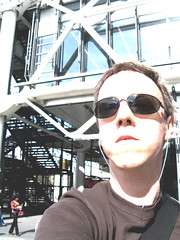
So the rumours of an
imminent update to the iPod (colour screen, bigger HD, photo sync, TV output, hip flask, yada yada) are back again,
quel surprise. Our considered opinion, based on what we know of Apple and some partially-informed speculation, is that (i) colour is eventually inevitable but battery life is more important, (ii) flicking through cd covers is natural and necessary but it'll take more than a screen update to make it work properly, and (iii) you don't screw around with a
92% market share.
The second point is worth expanding upon: The whole text tree structure of a 10,000 track iPod can happily sit in memory and be scrolled through in under 20 seconds. That's 500 titles a second. Now try that with 128 pixel-square images. Any acceptable scrolling experience has to at least match the 25fps or so we're used to in video, and even that's probably not high enough. Of course Apple could opt for just displaying the cover of the track that's playing, but we rather doubt that'll be considered an acceptable user experience. Give us direct digi-cam connection and bi-directional iPhoto synching however, and we'll trade our 40GB 3G in a heartbeat.
 The guys at mekentosj really know how to look beneath the surface of stuff. Not content with winning an Apple Design Award, they set about discovering how it worked (the apparently solid metal cube glows from within when touched) by CT scanning it and reconstructing the data as 3D visualisations. Aside from everything else, it's a beautiful example of what can be done with Open Source medical visualisation software on the Mac, and indicative of the rich possibilities for serious visualisation work on the platform.
The guys at mekentosj really know how to look beneath the surface of stuff. Not content with winning an Apple Design Award, they set about discovering how it worked (the apparently solid metal cube glows from within when touched) by CT scanning it and reconstructing the data as 3D visualisations. Aside from everything else, it's a beautiful example of what can be done with Open Source medical visualisation software on the Mac, and indicative of the rich possibilities for serious visualisation work on the platform.


 So the rumours of an
So the rumours of an 

